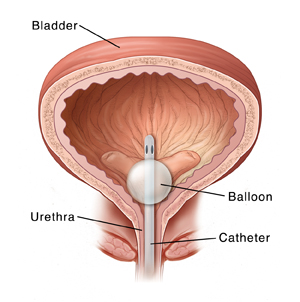A Foley catheter, also called an indwelling urinary catheter, is a flexible plastic or rubber tube that is placed through the urethra and into the bladder. The urethra is the opening where urine comes out. The catheter helps drain urine from the bladder. There is a small balloon on the end of the tube that is inflated after the catheter is put in place. This keeps the catheter from sliding out of the bladder.
A Foley catheter is used when you are unable to pass urine (urinary retention). It's also used when there is loss of bladder control (incontinence). It's also used after bladder or prostate surgery.
Home care
-
Take all the prescribed medicines including antibiotics as advised by your health care provider. Do not stop taking the medicines even if you feel better before the prescribed duration is over.
-
Wash your hands well with soap and water before and after handling a Foley catheter and collection bag.
-
It's important to keep bacteria from getting into the collection bag. Don't disconnect the catheter from the collection bag.
-
Use a leg band to secure the drainage tube, so it doesn't pull on the catheter.
-
Don't try to pull or remove your catheter. This will injure your urethra. It must be removed by your provider or nurse.
-
Drain the collection bag when it becomes full using the drain spout at the bottom of the bag.
Follow-up care
Follow up with your health care provider, or as advised. This is for repeat urine testing and for catheter removal or replacement.
When to get medical advice
Call 911 for any dizziness or fainting.
Contact your health care provider right away if:
-
You have a fever of 100.4ºF (38ºC) or higher, or as directed by your provider.
-
You have bladder pain or fullness.
-
You have abdominal swelling, nausea or vomiting, or back pain.
-
There is blood or urine leakage around the catheter.
-
Bloody urine is coming from the catheter (if a new symptom).
-
The catheter falls out.
-
The catheter stops draining for 6 hours.
-
You are feeling weak.


